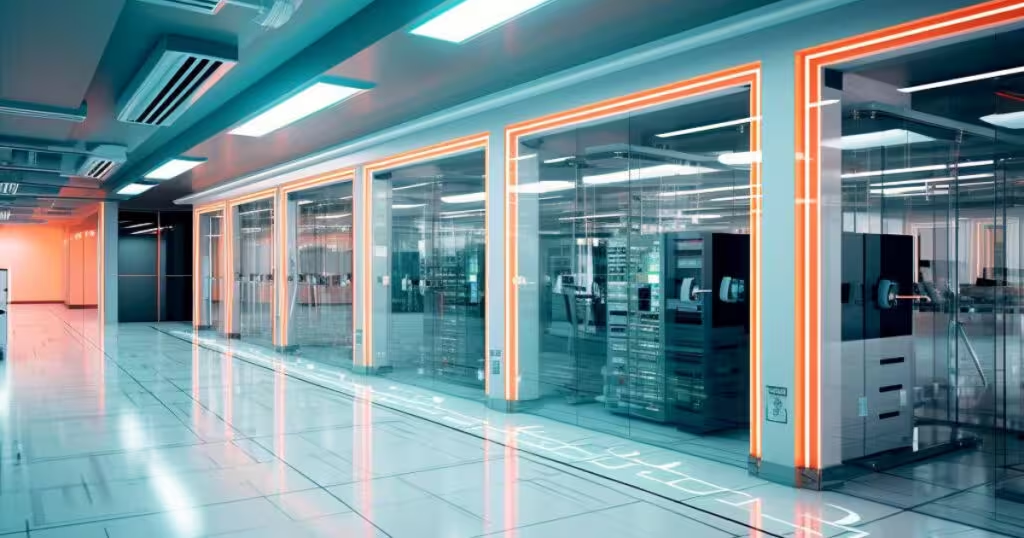
Building the Fortress: Security Best Practices for Colocation Data Centres in 2025

With escalating cyber threats and stringent data regulations, security in colocation data centres has become a top priority. As the digital landscape evolves, so do the security measures and technologies designed to protect critical assets. In 2025, leading data centres are adopting advanced security protocols, from biometric access control and AI-driven surveillance to zero-trust architectures, to safeguard client data and ensure uninterrupted operations.
This post dives into the latest security innovations that are redefining data centre protection and setting a new standard for colocation security.
Top Security Measures in Colocation Data Centres
1. Biometric Access Control for Secure Physical Entry
Ensuring that only authorised personnel have access to sensitive areas is a fundamental security principle. Biometric access control leverages fingerprint scans, facial recognition, or iris scans to authenticate identity, adding an advanced layer of physical security beyond traditional access cards or PIN codes. Biometric technology makes unauthorised access nearly impossible, as it is tied directly to a person’s unique physical characteristics.
By implementing multi-layered biometric systems, data centres can better protect their clients’ servers and sensitive data, ensuring that even in high-security areas, only verified individuals gain entry.
2. AI-Driven Surveillance for Proactive Monitoring
Artificial intelligence has made significant strides in security, with AI-driven surveillance systems now capable of monitoring, analysing, and responding to threats in real time. AI surveillance systems can detect unusual activities, such as unauthorised movements or potential intrusions, and trigger alerts immediately, giving security teams the chance to respond before an incident escalates.
This proactive approach not only strengthens physical security but also improves operational efficiency by automating repetitive monitoring tasks and enhancing overall situational awareness. For colocation facilities, AI surveillance is a game-changer, offering a high level of control over who and what is happening within their premises.
3. Zero-Trust Architecture: Never Trust, Always Verify
Zero-trust architecture is quickly becoming the industry standard in data security. Unlike traditional security models that grant broad network access, zero-trust assumes that every attempt to access data or systems could be a potential threat. This approach requires rigorous identity verification, restricted access permissions, and constant monitoring for every user and device attempting to connect to the network.
In colocation facilities, zero-trust principles ensure that sensitive data is only accessible to verified users on a need-to-know basis, minimising the attack surface and preventing internal and external breaches. This model offers an extra layer of security for clients, especially those with stringent compliance requirements or sensitive data handling needs.
4. Intrusion Detection and Prevention Systems (IDPS)
Intrusion detection and prevention systems (IDPS) play a critical role in monitoring network activity and identifying any suspicious or malicious behaviour. In a colocation setting, IDPS uses advanced algorithms to detect and respond to potential threats before they can infiltrate the network or reach critical assets. Modern IDPS solutions incorporate machine learning to enhance their accuracy over time, identifying and mitigating threats with minimal false positives.
By quickly identifying anomalous activity, IDPS ensures that the data centre environment remains secure and continuously monitored against evolving cyber threats.
5. Advanced Fire Suppression and Environmental Monitoring
Beyond cyber security, physical protection against fire and environmental hazards is paramount. Modern data centres use advanced fire suppression systems, often deploying clean-agent fire suppression, which doesn’t harm equipment or release toxic by-products. Environmental monitoring systems keep tabs on critical conditions such as humidity, temperature, and airflow, ensuring an optimal and safe environment for servers.
These systems work in tandem to prevent potential physical risks, providing an added layer of resilience that protects both infrastructure and data.
The Path to Future-Ready Colocation Security
As businesses place increasing value on security and compliance, colocation data centres are advancing their best practices to meet the needs of 2025 and beyond. By embracing biometric access, AI-driven surveillance, zero-trust models, and enhanced environmental monitoring, data centres are setting a new standard for safety, reliability, and peace of mind.
With these leading-edge security measures, data centres provide clients with a fortified environment that mitigates risks, supports compliance, and prioritises the security of critical data assets—ensuring they’re ready to meet the challenges of an ever-evolving digital landscape.